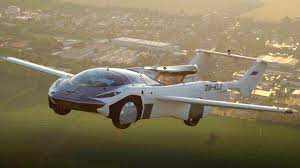Courtesy : en.wikipedia.org
Flying car
A flying car or roadable aircraft is a type of vehicle which can function both as a road vehicle and as an aircraft. As used here, this includes vehicles which drive as motorcycles when on the road. The term “flying car” is also sometimes used to include hovercars and/or VTOL personal air vehicles.
Many prototypes have been built since the early 20th century, using a variety of flight technologies. Most have been designed to take off and land conventionally using a runway. Although VTOL projects are increasing, none has yet been built in more than a handful of numbers.
Their appearance is often predicted by futurologists, and many concept designs have been promoted. But their failure to become a practical reality has led to the catchphrase “Where’s my flying car?”, as a paradigm for the failure of predicted technologies to appear.
Flying cars are also a popular theme in fantasy and science fiction stories.
History
Early 20th century
In the late 1800s, American immigrant Gustave Whitehead designed aircraft with wheels and a gasoline-powered engine, including his no.21 model built in 1901.Consensus among historians is that Whitehead’s no. 21 did not achieve sustained self-powered flight. Some historians continue to assert Whitehead’s craft flew at various dates prior to the Wright Brothers’ craft, based on a series of unverifiable and contradictory eye-witness accounts.
Aircraft designer Glenn Curtiss built his Autoplane in 1917. It had a pusher propeller for flight, with removable flight surfaces including a triplane wing, canard foreplane and twin tails. It was able to hop, but not fly.
In 1935, Constantinos Vlachos built a prototype of a ‘tri-phibian’ vehicle with a circular wing, but it caught fire after the engine exploded while he was demonstrating it in Washington, D.C. Vlachos was badly injured and spent several months in hospital. The machine is most notable for a newsreel that captured the incident.
The Autogiro Company of America AC-35 was a prototype roadable autogyro, flown on 26 March 1936 by test pilot James G. Ray. Forward thrust was initially provided by twin counter-rotating propellers for thrust, later replaced with a single propeller. On 26 October 1936, the aircraft was converted to roadable configuration. Ray drove it to the main entrance of the Commerce Building, Washington, D.C., where it was accepted by John H. Geisse, chief of the Aeronautics Branch. Although it had been successfully tested, it did not enter production.
The first fixed wing roadable aircraft to fly was built by Waldo Waterman. Waterman was associated with Curtiss while Curtiss was pioneering amphibious aircraft at North Island on San Diego Bay in the 1910s. On 21 March 1937, Waterman’s Arrowbile first took to the air. The Arrowbile was a development of Waterman’s tailless aircraft, the Whatsit.It had a wingspan of 38 feet (12 m) and a length of 20 feet 6 inches (6.25 m). On the ground and in the air it was powered by a Studebaker engine. It could fly at 112 mph (180 km/h) and drive at 56 mph (90 km/h).
In 1942, the British army built the Hafner Rotabuggy, an experimental roadable autogyro that was developed with the intention of producing a way of air-dropping off-road vehicles. Although initial tests showed that the Rotabuggy was prone to severe vibration at speeds greater than 45 miles per hour (72 km/h), with improvements the Rotabuggy achieved a flight speed of 70 mph (113 km/h). However, the introduction of gliders that could carry vehicles (such as the Waco Hadrian and Airspeed Horsa) led to the project’s cancellation.
Late 20th century
Although several designs (such as the ConVairCar) have flown, none have enjoyed commercial success, and those that have flown are not widely known by the general public. The most successful example, in that several were made and one is still flying, is the 1949 Taylor Aerocar.
In 1946, the Fulton FA-2 Airphibian was an American made flying car designed by Robert Edison Fulton Jr., it was an aluminum-bodied car, built with independent suspension, aircraft-sized wheels, and a six-cylinder 165 hp engine. The fabric wings were easily attached to the fuselage, converting the car into a plane. Four prototypes were built. Charles Lindbergh flew it 1950 and, although it was not a commercial success (financial costs of airworthiness certification forced him to relinquish control of the company, which never developed it further), it is now in the Smithsonian.
1949 Aerocar with wings folded, at the EAA AirVenture Museum
The Aerocar, designed and built by Molt Taylor, made a successful flight in December 1949, and in following years versions underwent a series of road and flying tests. Chuck Berry featured the concept in his 1956 song “You Can’t Catch Me”, and in December 1956 the Civil Aviation Authority approved the design for mass production, but despite wide publicity and an improved version produced in 1989, Taylor did not succeed in getting the flying car into production. In total, six Aerocars were built. It is considered to be one of the first practical flying cars.
One notable design was Henry Smolinski’s Mizar, made by mating the rear end of a Cessna Skymaster with a Ford Pinto, but it disintegrated during test flights killing Smolinski and the pilot.
Moller began developing VTOL craft in the late 1960s, but no Moller vehicle has ever achieved free flight out of ground effect. The Moller Skycar M400was a project for a personal VTOL (vertical take-off and landing) aircraft which is powered by four pairs of in-tandem Wankel rotary engines. The proposed Autovolantor model had an all-electric version powered by Altairnano batteries.The company has been dormant since 2015.
In the mid-1980s, former Boeing engineer Fred Barker founded Flight Innovations Inc. and began the development of the Sky Commuter, a small duct fans-based VTOL aircraft. It was a compact, 14-foot-long (4.3 m) two-passenger and was made primarily of composite materials.In 2008, the remaining prototype was sold for £86k on eBay.



